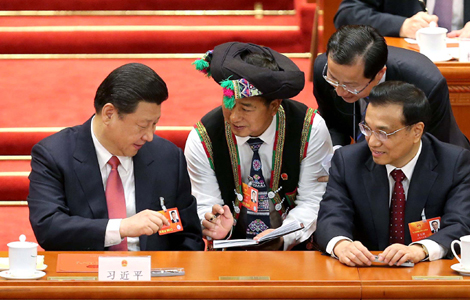Full text: Report on China's economic, social development plan
Updated: 2013-03-19 20:227. New results were achieved in ensuring and improving the people's wellbeing.
The overall employment situation remained stable. An additional 12.66 million urban jobs were created, 3.66 million more than the targeted amount, and the urban registered unemployment rate at the end of 2012 stood at 4.1%, well below the target. Individual income increased rapidly, with urban per capita disposable income reaching 24,565 yuan and rural per capita net income reaching 7,917 yuan, up 9.6% and 10.7%, in real terms after adjusting for inflation, respectively, both higher than the economic growth rate. We further increased the level of social security benefits. We realized the full coverage of the new type of old-age insurance for rural residents and the old-age insurance system for non-working urban residents, launched the major disease insurance pilot program for rural and non-working urban residents, and increased government subsidies for the new type of rural cooperative medical care system and the basic medical insurance scheme for non-working urban residents to 240 yuan per person per year. By the end of 2012, urban population covered by basic old-age, basic medical, unemployment, worker' s compensation, and maternity insurance totaled 324.8 million, 535.89 million, 152.25 million, 189.93 million, and 154.45 million, respectively, and the number of people covered by the new type of old-age insurance for rural residents reached 462.69 million. The system of subsistence allowances benefited 53.409 million rural residents and 21.425 million urban residents. While continuing to strengthen regulation of the real estate market, we further increased support for government-subsidized housing development. Last year we basically completed work on 6.01 million units of government-subsidized housing in urban areas and began construction on an additional 7.81 million units, with both numbers exceeding the planned figures.
Social programs developed faster than before. Steady progress was made in promoting education reform and development. In 2012, government spending on education reached the target of 4% of GDP, and the three-year safety renovation program for primary and secondary school buildings was basically completed. We continued to build dormitories for teachers at rural schools in remote areas and areas with harsh conditions, promote rural preschool education, and carry out the pilot project to improve nutrition for rural students receiving compulsory education. We promulgated and implemented the regulations on ensuring school bus safety. The tuition exemption policy for secondary vocational education was extended to cover all rural students. We basically solved the problem of ensuring children of rural migrant workers have access to compulsory education in cities where they live, and worked in an orderly manner to help these children take part in local high school and college entrance examinations. The retention rate of nine-year compulsory education was 92%, up 0.5 percentage points over the previous year, the gross enrollment ratio for senior secondary education reached 85%, up 1 percentage point, and regular undergraduate and graduate enrollment totaled 6.888 million and 590,000, respectively, all meeting the targets. We improved our ability to provide medical and health care services. The community-level medical and health care service system was further improved in urban and rural areas. We accelerated development of the emergency medical service system in rural areas, the prevention and control system for major diseases, health oversight institutions at the county level, and the children' s medical service system. We gradually tied in information about medical services, drug oversight, medical insurance, public health, and overall medical management. Training of general practitioners was intensified. Hospitals and health clinics provided 3.73 beds per 1,000 people, up 6.6% year on year. The public cultural services system continued to improve. We continued to extend radio and television coverage to villages. We supported ethnic minorities' capacity building in the press and publishing, and also supported development of prefecture-level facilities for public cultural services and facilities for preserving national cultural and natural heritage sites. We started implementing the fifth phase of the Tibet-Xinjiang Project to extend radio coverage in the western region. Museums, libraries, and cultural centers were opened to the public free of charge. The culture industry system further improved, and the culture industry as a whole grew in both scale and strength. We promulgated and implemented the plan for improving tourism infrastructure and the plan for carrying out the second phase of the project to develop tourist sites related to the early history of the CPC. Annual income from tourism totaled 2.59 trillion yuan, an increase of 15.2% over the previous year. Public sports venues of all kinds exceeded one million. The natural population growth rate, which met the target, was 4.95 per thousand.


